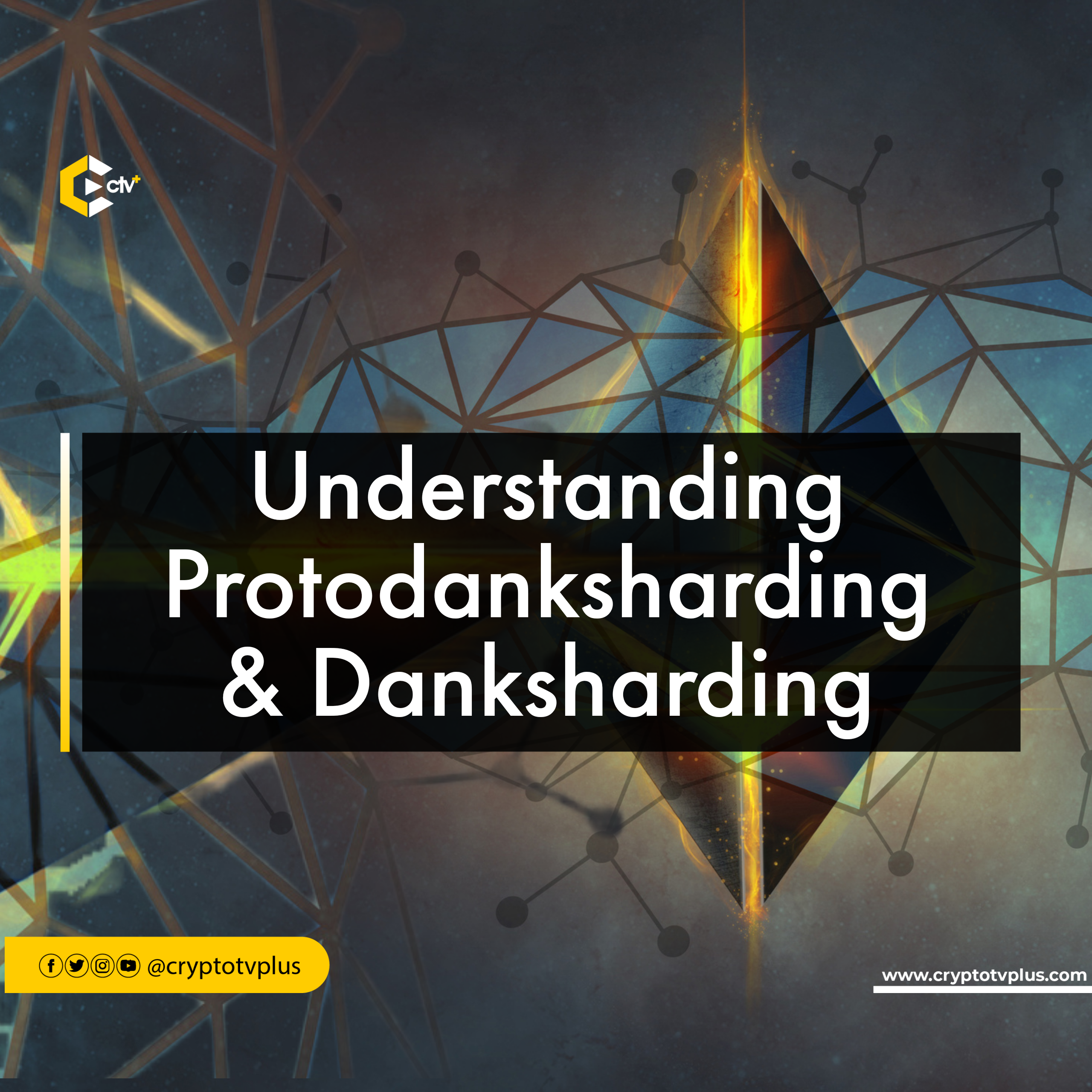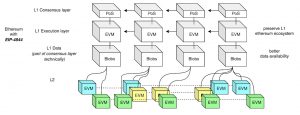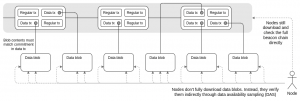Education
Protodanksharding and Danksharding Explained

Ethereum has faced challenges with scalability, leading to network congestion and high transaction fees during periods of high demand. To overcome these obstacles, developers have been actively working on a series of updates as part of the Ethereum 2.0 (ETH2) upgrade. Protodanksharding and Danksharding are integral components of this upgrade, aiming to enhance scalability by scaling the on-chain data capacity and improving network efficiency.
The primary objective of both Protodanksharding and Danksharding is to ensure that the data stored on the Ethereum blockchain remains accessible to archiving parties from the moment it was initially posted.
This goal is accomplished through a technique known as Data Availability Sampling (DAS). By scaling the on-chain data capacity, Ethereum can accommodate the expanding utility and demand for the network, opening up new possibilities for developers and decentralized applications.
What is Sharding?
Sharding is a technique commonly used in centralized database management, and its application in blockchain networks aims to improve scalability and efficiency. In the context of Ethereum, sharding involves dividing the network into distinct shards, each responsible for storing a portion of the chain’s data and handling a unique subset of transactions. By distributing the workload across multiple shards, sharding allows for parallel processing, thereby increasing the network’s capacity to handle a higher volume of transactions.
The key concept behind sharding is the division of data and transaction processing responsibilities. Instead of every node on the network processing and storing all the data and transactions, shards enable a more efficient and scalable approach. Each shard operates as an independent chain within the Ethereum network, maintaining its own state and processing its allocated transactions.
Benefits Sharding Brings to Ethereum
1. Increased scalability
By dividing the network into shards, each responsible for a subset of data and transactions, sharding enables parallel processing and enhances the network’s overall capacity to handle a larger volume of transactions.
2. Improved performance
With sharding, transactions can be processed in parallel across multiple shards, leading to faster transaction confirmation times and reduced congestion on the network.
3. Lower resource requirements
Sharding reduces the computational and storage requirements for individual nodes on the network. Instead of storing the entire blockchain, nodes only need to maintain the data relevant to their assigned shard.
4. Enhanced fault tolerance
Sharding enhances the fault tolerance of the network. If a single shard experiences a failure or congestion, it does not impact the entire network, as other shards continue to function independently.
However, implementing sharding in a decentralized and secure manner presents challenges. This is because ensuring data consistency and cross-shard communication while maintaining the integrity and security of the network requires careful design and coordination.
Protodanksharding and Danksharding are approaches that address these challenges and further enhance Ethereum’s scalability by leveraging sharding techniques.
Danksharding Architecture
Danksharding introduces a specific architecture for implementing sharding in Ethereum, focusing on the division and storage of persistent data into blobs. This architecture enhances scalability and efficiency by optimizing data storage and processing within the Ethereum network.

Source: Luozhu 📜 on Twitter
1. Blobs and Persistent Data Storage
One of the primary advancements in Danksharding is the substantial increase in the number of blobs per block. In Danksharding, persistent data storage is divided into blobs. A blob is a discrete unit of data that can be stored, processed, and retrieved independently. By breaking down data into blobs, Ethereum can effectively handle and distribute large amounts of information across the network. While ProtoDanksharding enables up to 512 KB of additional data per block, Danksharding expands this capacity further. It increases the maximum number of blobs per block, leading to a potential data storage capacity of 30 MB, a 60x improvement compared to ProtoDanksharding.
2. Increased Blob Capacity
Danksharding significantly expands the number of blobs attached to blocks compared to its predecessor, Protodanksharding. While Protodanksharding allows for one blob per block, Danksharding enables up to 64 blobs per block. This increase in blob capacity dramatically enhances the amount of data that can be stored and processed within a single block.
3. Data Availability and Interpretation
Danksharding addresses the challenge of storing and retrieving large amounts of data by dispersing the blobs among validators. In Danksharding, the Ethereum protocol itself does not interpret the blobs of data directly. Instead, it allows for more space dedicated to data storage and processing. Each validator only stores a small subset of the data, ensuring that no single validator holds all the information. This approach offers greater flexibility and scalability, as developers and smart contracts can implement their own interpretation and utilization of the stored data within the blobs.
4. Dispersed Storage and Block Reconstruction
To ensure data availability and integrity, Danksharding disperses the blobs among validators. Each validator stores only a small subset of the data. However, this introduces the challenge of reconstructing a block from the dispersed fragments of data. To address this, the block is encoded using erasure coding and broken into overlapping fragments. These fragments are then sent to validators, who verify their consistency with the signed commitments received from the block builder.
The process can be summarized as follows:
– The client sends data blobs (transactions or bundles) to a builder.
– The builder creates a block and sends pieces of it to validators.
– A block proposer, one of the validators, shares the block on the network.
– A sampling validator verifies the block header through a sampling protocol and signs it.
– A reconstruction agent rebuilds a previous block by interacting with all validators.
By distributing the data storage and verification tasks across multiple validators, Danksharding enhances the network’s fault tolerance and ensures the availability and security of the data.
5. Scaling Ethereum’s Throughput
With its enhanced data storage and processing capabilities, Danksharding contributes to scaling Ethereum’s throughput. By enabling the storage of larger amounts of data on-chain and improving the efficiency of transaction processing, Danksharding supports the execution of hundreds of individual rollups and facilitates a substantial increase in the number of transactions per second. This scalability is crucial for meeting the growing demands of decentralized applications and other use cases within the Ethereum ecosystem.
What is ProtoDanksharding?
ProtoDanksharding serves as an intermediary update on the path towards full Danksharding implementation. It introduces new transaction types and lays the foundation for the enhanced data storage and processing capabilities of Danksharding.

Source: Moralis
Let’s explore the key aspects of ProtoDanksharding:
1. Blob-Carrying Transactions
ProtoDanksharding introduces a new transaction type called a “blob-carrying transaction.” Each blob represents a data packet of up to 128 KB. A transaction can carry up to four data blobs, totalling up to 512 KB of additional data per block. This significantly increases the amount of data that can be included and stored on-chain.
2. Limited Storage Time and Data Accessibility
In ProtoDanksharding, the data blobs are stored for a limited period, and the data within them is not directly accessible to smart contracts. Instead, only a short commitment to the blob data, called DATAHASH, is made available to smart contracts. This approach balances the need for increased data capacity while maintaining efficiency and minimizing the impact on on-chain execution.
3. Rollup-Centric Approach
ProtoDanksharding adopts a rollup-centric approach, which focuses on simplifying and expanding the capacity for data blobs. By leveraging rollups, which are Layer 2 solutions that aggregate transactions and provide more efficient processing, ProtoDanksharding optimizes data storage on Layer 1 (L1) and enhances scalability. The goal is to maximize the available space on L1 and utilize L2 solutions to handle the bulk of the transaction processing.
4. Scaling Potential
ProtoDanksharding lays the foundation for future scalability enhancements by expanding the capacity and efficiency of data storage. By accommodating larger amounts of data on-chain and optimizing for Layer 2 solutions, Ethereum can scale by orders of magnitude. This scalability is essential to support the growing utility and demand for the Ethereum network, enabling it to handle a significantly increased transaction throughput.
Implications and Benefits of Danksharding
Danksharding, with its advanced sharding architecture and increased data storage capabilities, brings forth several implications and benefits for Ethereum and its ecosystem.
1. Enhanced Scalability
The primary benefit of Danksharding is its ability to significantly improve the scalability of the Ethereum network. By dividing the network into shards and increasing the data storage capacity with an extensive number of blobs per block, Danksharding allows for a substantial increase in transaction throughput. This scalability enhancement enables Ethereum to handle a higher volume of transactions, making it more efficient and suitable for various decentralized applications and use cases.
2. Reduced Transaction Fees
With the increased scalability provided by Danksharding, Ethereum can mitigate network congestion and reduce transaction fees. The distribution of data processing and storage across multiple shards alleviates the burden on individual nodes, resulting in faster transaction confirmation times and more cost-effective transactions. Lower transaction fees make Ethereum more accessible and encourage wider adoption and usage.
3. Expanded Data Storage and Processing
Danksharding significantly expands the on-chain data storage capacity of Ethereum. With the ability to store larger amounts of data per block, developers have more room to innovate and build applications that rely on on-chain data. This expanded data storage also opens up opportunities for new use cases and enhances the capabilities of smart contracts. Developers can leverage the increased blob capacity to store and process diverse types of data, enabling more complex and sophisticated decentralized applications.
4. Efficient Data Retrieval and Availability
The sharding approach of Danksharding ensures efficient data retrieval and availability. By dispersing the blobs among validators and employing erasure coding, the network ensures that the complete data set is available to clients. This distribution of data enhances fault tolerance, as the failure or unavailability of a single validator does not result in the loss of the entire dataset. Clients can access the required data from multiple validators, improving the overall reliability and availability of data on the network.
5. Compatibility with Layer 2 Solutions
Danksharding is designed to be compatible with Layer 2 scaling solutions, such as rollups. By optimizing data storage and processing on Layer 1 (L1) and utilizing Layer 2 (L2) solutions for transaction aggregation and execution, Danksharding creates a powerful combination that maximizes scalability and efficiency. This compatibility with Layer 2 solutions allows Ethereum to handle a significantly increased transaction throughput and reduces the burden on the main network, further enhancing the overall performance and user experience.
Schedule for Protodanksharding and Danksharding implementation
Protodanksharding is scheduled to be rolled out in EIP4844 as part of the Cancun update, expected to occur later this year. This initial implementation will introduce the concept of blob-carrying transactions and enable limited data storage on-chain. Following Protodanksharding, Danksharding will be introduced at a later date, further increasing the amount of data available to clients and enhancing Ethereum’s scalability.
The Future of Ethereum with Danksharding
Danksharding represents a significant milestone in the evolution of Ethereum’s scalability and data storage capabilities:
1. Enhanced Adoption and Usability
With Danksharding in place, Ethereum becomes more accessible and usable for a wide range of applications. The increased scalability, reduced transaction fees, and expanded data storage capacity make Ethereum a more attractive platform for developers and users alike. This enhancement paves the way for the broader adoption of decentralized applications and enables innovative use cases that were previously limited by scalability and cost constraints.
2. Diverse Decentralized Applications
Danksharding opens up opportunities for developers to create complex and data-intensive decentralized applications. With the increased data storage capacity, developers can build applications that require storing and processing larger amounts of on-chain data, such as decentralized finance (DeFi) protocols, gaming platforms, supply chain management systems, and more. The enhanced scalability also allows for the seamless integration of various Layer 2 solutions, further expanding the possibilities for decentralized applications.
3. Improved User Experience
As Ethereum scales with Danksharding, users will experience improved transaction speeds and reduced fees. The enhanced scalability and data availability lead to faster confirmation times and smoother interactions with decentralized applications. This improved user experience encourages wider adoption and facilitates a more seamless transition from traditional web applications to decentralized alternatives.
4. Interoperability and Ecosystem Growth
Danksharding plays a crucial role in fostering interoperability within the Ethereum ecosystem. With increased scalability, Ethereum can accommodate a multitude of individual rollups, enabling seamless integration between different Layer 2 solutions and decentralized applications. This interoperability encourages collaboration, innovation, and the growth of the Ethereum ecosystem as developers and projects can leverage each other’s functionalities and build upon existing infrastructure.
5. Continued Research and Development
The integration of Danksharding into the Ethereum network marks a significant milestone in blockchain technology. To keep Ethereum at the forefront of innovation, developers and researchers will continue to optimize and refine the sharding architecture. Ongoing research efforts will focus on enhancing data availability, minimizing erasure coding overheads, and refining sharding protocols. Through continuous improvement, Ethereum can adapt to evolving demands and challenges, cementing its position as a leading blockchain platform.
Conclusion
Danksharding is fundamentally shifting the landscape of Ethereum. By enabling unparalleled scalability, wider data storage, and optimizing the user experience, Danksharding will drive unparalleled growth in user adoption and decentralized applications.
Adopting and refining Danksharding technology will position Ethereum as an unquestioned leader in the blockchain space, allowing for infinite use cases and innovations that will continue to disrupt, reshape, and redefine the industry.
Read also:
https://cryptotvplus.com/2022/12/how-bitcoin-lightning-is-scaling-payment/













1 Comment